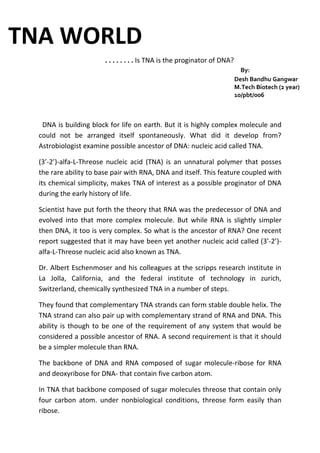
Tna world desh 2
- 1. TNA WORLD . . . . . . . . Is TNA is the proginator of DNA? By: Desh Bandhu Gangwar M.Tech Biotech (2 year) 10/pbt/006 DNA is building block for life on earth. But it is highly complex molecule and could not be arranged itself spontaneously. What did it develop from? Astrobiologist examine possible ancestor of DNA: nucleic acid called TNA. (3’-2’)-alfa-L-Threose nucleic acid (TNA) is an unnatural polymer that posses the rare ability to base pair with RNA, DNA and itself. This feature coupled with its chemical simplicity, makes TNA of interest as a possible proginator of DNA during the early history of life. Scientist have put forth the theory that RNA was the predecessor of DNA and evolved into that more complex molecule. But while RNA is slightly simpler then DNA, it too is very complex. So what is the ancestor of RNA? One recent report suggested that it may have been yet another nucleic acid called (3’-2’)- alfa-L-Threose nucleic acid also known as TNA. Dr. Albert Eschenmoser and his colleagues at the scripps research institute in La Jolla, California, and the federal institute of technology in zurich, Switzerland, chemically synthesized TNA in a number of steps. They found that complementary TNA strands can form stable double helix. The TNA strand can also pair up with complementary strand of RNA and DNA. This ability is though to be one of the requirement of any system that would be considered a possible ancestor of RNA. A second requirement is that it should be a simpler molecule than RNA. The backbone of DNA and RNA composed of sugar molecule-ribose for RNA and deoxyribose for DNA- that contain five carbon atom. In TNA that backbone composed of sugar molecules threose that contain only four carbon atom. under nonbiological conditions, threose form easily than ribose.
- 2. But it is not only the number of the carbon atoms that threose an intrisically simpler molecule than ribose. it is also the fact that, unlike ribose, the simplest formation of threose requires only a single type of starting material. TNA does not occur naturally today. Scientists have to create it in the lab in order to study it. Since we can’t go back in time to witness the evolution of nucleic acid, we will never to prove whether natural TNA made an appearance on earth. But scientist can examine the basic property of TNA and determine whether they could have formed in a prebiotic earth environment. The reason for synthesizing and studying it to screen the structural nighborhood of RNA for potential nucleic acid alternative that could also have fulfilled the function of genetic system. The origin of DNA are confronted with a paradox. DNA needs certain proteins to replicate. But in order to make the correct proteins for this function, modern cells need to have DNA. Since DNA and the proteins are dependent on each other. It is hard to see how either of them could have come first. One answer to this riddle is the RNA world theory, which suggested that both DNA and protein could descendents of RNA. But where did RNA come from? To date no one has been able to form RNA under in the laboratory under condition that mimic those believed to have existed on primitive earth. Some scientist also question whether nucleic acid with a backbone of ribose, or any other sugar molecule, would be stable enough to survive the harsh condition of early earth. So it is generally agreed that RNA must have evolved from an earlier form, while TNA is a good candidate other polymer that exhibit self replication and base pairing could have evolved into RNA. TNA is the best bet so far.
